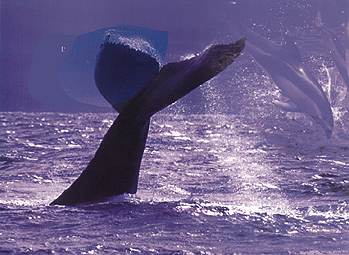 |
|
|
THE SEARCH FOR THE REAL MOBY DICK
"I wonder if ...." "Shhhh", - "sorry", a whispered exchange... All 20 people on board the boat seemed to be straining to hear something in the strange sounds emanating from the onboard hydrophone, which would tell them just WHERE the sperm whale would surface... I looked down. The sea was so clear, I felt as if I could see ....... What was that huge, black shape? WHOOSH! I was showered by a blow from the surfacing sperm whale, who, as I shook the droplets from my hair, fixed me with her beady stare, and with a flick of her tail was off to rejoin her pod. She had left her calf in charge of its aunties and had gone looking for food in the depths of the waters off Soufriere on the stunning west coast of St. Lucia. The pod moved slowly south, socializing, vocalizing and generally going about their business as though we mere mortals didn't exist. What a wonderful excursion! Further north, we had been entertained by a large group of pilot whales, playing in the wake of the boat, and almost all the way south had been accompanied by different species of dolphin. We had seen flying fish in abundance - they can really fly, and pretty far! The seabirds whirling overhead - terns, boobies skimming the waves with the tips of their wings, and highest of all, the magnificent frigate bird. Our knowledgeable guide Patrick had helped us to differentiate between the dolphins' clicks and whistles and the sounds that would tell us a sperm whale was feeding far below us. The hydrophone adds a whole dimension to the whale watching experience, helping one to picture what might be going on in the murky depths. A world we humans are ill-equipped to explore. We had been instructed not to feed the dolphins as this is considered a form of harassment, but no one had said not to feed the birds, so by now the sky seemed filled with wheeling, screeching argumentative terns. The St. Lucia Whale and Dolphin Watching Association was formed in 1996, by a group of people interested in promoting whale watching as a local enterprise. Licensing requirements and whale watching regulations, the first in the Eastern Caribbean, were thrashed out at sessions with the Department of Fisheries, and while the skeptics scoffed and laughingly compared St. Lucia with Dominica, the whale watching capital of the Eastern Caribbean, our first two operators found that demand for these outings continued to increase. Whale watching is now among the most popular excursions on offer by local tour operators, and the benefits filter down to hundreds of St. Lucians. The waters of the Eastern Caribbean are home to many species of the order cetacea. Over 30 species, including several of the so-called "great whales" can be sighted at one time or another during the year. The pilot whales and dolphins are here all year round, as are the female and juvenile sperm whales. The gigantic male sperm whales migrate annually from colder waters to mate in the Tropics. The north Atlantic humpbacks come to the Caribbean every winter to calve and build up their calves' strength to enable them to endure the long trip back up north to their homes off such places as Cape Cod, where many are known by name by local whale watch operators and researchers. Silver Bank, which is north of the Dominican Republic, a thousand miles north of St. Lucia boasts the Caribbean's oldest whale sanctuary. Just recently, a sanctuary was also declared in the waters of the French dependencies of Guadeloupe, St. Martin and St. Barts. Marine reserves exist throughout the Caribbean, and many species are thus protected in near-shore waters. St. Lucia and neighbouring St. Vincent and the Grenadines have a history of whaling. St. Vincent still hunts the humpback whale under International Whaling Commission regulations, and has a fairly important small cetacean fishery. St. Lucia's foray into whaling was short-lived. Pigeon Island was used as a whaling station at the beginning of the 20th century by Yankee whalers and fishermen from nearby St. Vincent. Several countries in the region have now signed up to the Specially Protected Areas and Wildlife or SPAW protocol of the Cartegena Convention. The French government is currently considering the creation of a Marine sanctuary in the Caribbean waters which comprise its EEZ. Although St. Lucia is afforded an exemption under the SPAW protocol for subsistence fisheries and dolphin and pilot whale meat is still consumed here, the trickle-down effect of the whale watching industry, not to mention the overall dollar value both direct and to peripheral businesses is, of course already much greater. Dominica's pioneers in the whale watching business, the Armour family are in the process of branching out into Sperm Whale research, and St. Lucia Whale and Dolphin Watching Society members hope soon to be in a position to work on an interpretation centre so that information on the region's many cetaceans can be readily accessible to St. Lucians and visitors alike. Look out for the soon-to-be-published CaribWhale, (an association of the region's whale watchers) brochure.
|
|
|
|
||||||||||||||||||||
|
© 2001-2004 Island Visions Ltd. |
